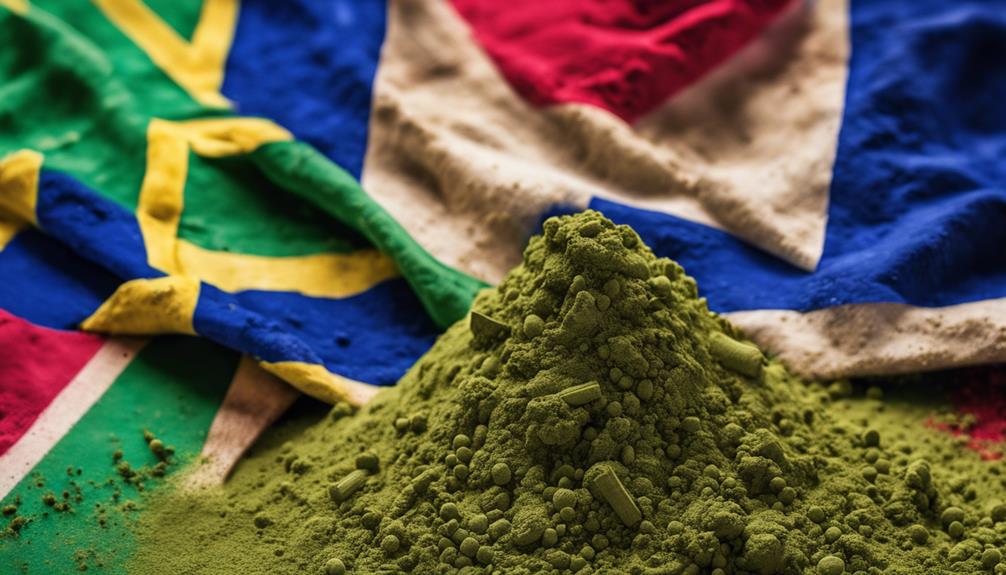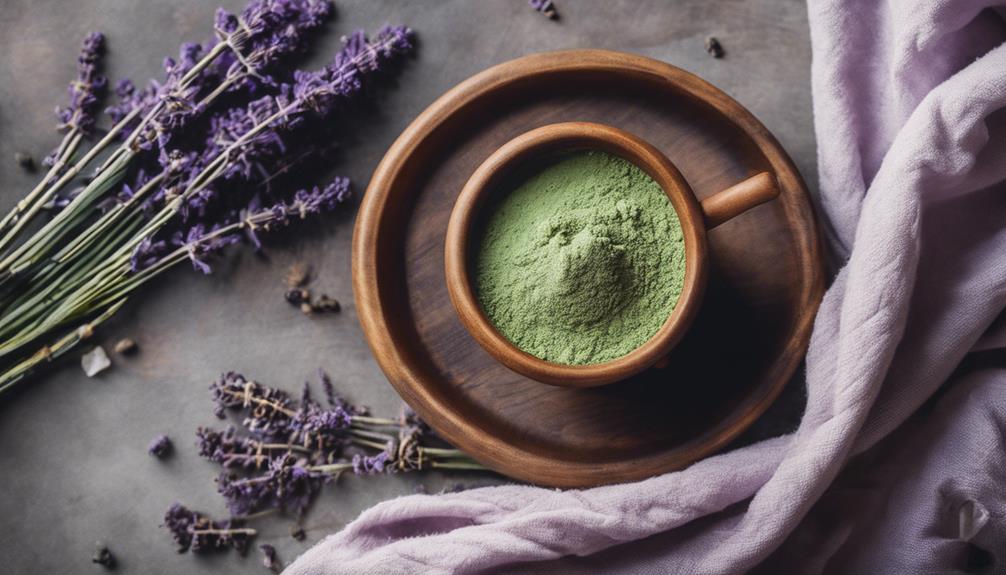Deprecated: mb_convert_encoding(): Handling HTML entities via mbstring is deprecated; use htmlspecialchars, htmlentities, or mb_encode_numericentity/mb_decode_numericentity instead in /home/users/kratomfiles/www/kratomfiles.com/wp-content/plugins/quick-adsense-reloaded/includes/template-functions.php on line 3552
As you start to explore the intricacies of Kratom powder, you may find yourself intrigued by its diverse potential applications and effects. With a history steeped in cultural traditions and modern-day controversies, this herbal substance presents a complex tapestry awaiting investigation. From its origins in Southeast Asia to its current status in Western societies, the journey through Kratom powder's nuances promises a deeper understanding of its allure and complexities. Let's explore the world of Kratom powder to uncover its secrets and mysteries.
Key Takeaways
- Kratom powder origins from Mitragyna speciosa tree.
- Various consumption methods: tea, toss and wash, capsules.
- Historical use in Southeast Asian traditional medicine.
- Regulatory concerns: lack of FDA approval, legal status variations.
- Effects, benefits, risks, and dosage considerations important.
Understanding Kratom Powder Origins

Kratom powder, derived from the dried leaves of the Mitragyna speciosa tree native to Southeast Asia, holds a long history in traditional medicine practices. These leaves have been traditionally harvested, dried, and ground into a fine powder for consumption. Throughout centuries, various cultures in Southeast Asia have utilized kratom powder for its potential medicinal properties. The process of grinding the leaves into a powder form has allowed for easier consumption and absorption of the plant's compounds.
In traditional medicine, kratom powder has been used for its potential energizing, calming, and pain-relieving effects. Different strains of kratom powder, such as Red Vein, Maeng Da, Bali, Gold, and Red Bali, offer varying characteristics and potential benefits. The diverse colors of kratom powder, including Red, Green, White, and Gold/Yellow, play a role in determining the unique properties and experiences associated with each strain. This rich history and cultural significance make kratom powder a fascinating subject of exploration for those interested in traditional herbal remedies.
Forms of Kratom Consumption
When it comes to consuming kratom powder, users have options like the toss and wash method or brewing it into tea. Mixing the powder into smoothies or meals also allows for a personalized experience. Experimenting with different ways to consume kratom powder can help you find the method that suits you best.
Powder Vs. Capsules
In the domain of kratom consumption, the choice between powder and capsules presents users with distinct advantages and considerations to weigh. Kratom powder offers versatility in preparation, allowing for customized dosages to meet individual needs. It can be mixed into various beverages like tea, smoothies, or used in cooking, enhancing the overall experience. On the other hand, capsules provide convenience through pre-measured servings and portability, making them ideal for quick and discreet consumption, especially while on the move. While powder allows for personalized blends and tailored consumption methods, capsules offer simplicity and ease of use without the need for preparation. Whether you prefer the flexibility of powder or the convenience of capsules, both forms cater to different preferences and lifestyles.
Tea Infusions
Enhancing your kratom consumption experience through traditional methods, tea infusions offer a convenient and enjoyable way to incorporate kratom powder into your routine. Kratom tea infusions have been historically used for potential health benefits and provide a soothing way to consume kratom. Adding lemon juice to your kratom tea can help with alkaloid extraction and improve the overall flavor. To mask the bitterness of the powder, consider adding sugar or honey to your tea. Below is a table summarizing key points about kratom tea infusions:
| Benefits | Preparation |
|---|---|
| Soothing | Brew kratom powder |
| Health potential | Add lemon juice |
| Convenient | Consider sweeteners |
| Traditional | Enjoy hot or cold |
Historical Use of Kratom

Throughout centuries, kratom has been a staple in Southeast Asian traditional practices, revered for its natural healing properties. The traditional use of kratom by Kratom users encompasses a wide range of therapeutic potential, with historical accounts indicating its effectiveness in managing pain, alleviating diarrhea, and even assisting in opioid withdrawal symptoms. In Southeast Asia, kratom was traditionally consumed by either chewing the leaves directly or brewing them into tea, highlighting its versatile applications. The historical use of kratom reflects its deep-rooted significance as a natural herbal medicine that has been integrated into cultural practices for generations. This long-standing history underscores the diverse ways in which traditional kratom has been utilized for its medicinal benefits, showcasing its adaptability in addressing various health concerns in traditional settings. The rich tapestry of historical use surrounding kratom illustrates its enduring reputation as a valuable botanical resource with a multitude of therapeutic properties.
FDA Approval Concerns
Given the lack of FDA approval for any medical use of kratom powder, concerns regarding its safety and efficacy have been raised, particularly in relation to potential addiction risks associated with its active compounds. When considering the use of kratom, it is vital to acknowledge the following points:
- FDA Approval Concerns: Kratom lacks FDA approval for medical purposes due to limited scientific evidence supporting its effectiveness.
- FDA Warning: The FDA advises against kratom consumption, highlighting the addiction risks tied to its active components.
- DEA Classification: The Drug Enforcement Administration classifies kratom as a drug of concern, indicating regulatory and safety worries surrounding its usage.
- Consultation with Healthcare Providers: Due to the limited understanding of kratom's full effects and potential interactions with other substances, seeking medical advice before using it is essential for ensuring safe consumption.
When dealing with the landscape of kratom use, being aware of these FDA approval concerns, DEA classification, and the importance of seeking medical advice can aid in making informed decisions about its usage.
Legal Status Variations

As you explore the legal status variations surrounding kratom, it is important to understand the state regulations and international legal restrictions that govern its use. Each state has its own set of rules regarding the sale and consumption of kratom, which can impact its availability and legality. Additionally, international laws may impose further restrictions on the import and export of kratom products, influencing its accessibility worldwide.
State Regulations on Kratom
State regulations on kratom vary widely across the United States, impacting its legal status and availability within different regions.
- Six states have banned kratom sales due to safety and abuse concerns.
- The FDA has warned about kratom's addictive properties and associated risks.
- The DEA classifies kratom as a drug of concern, requiring monitoring.
- Legal status inconsistencies lead to ongoing debates on its classification.
These variations in state regulations contribute to the complexities surrounding kratom's legality and use, with differing perspectives on how to address its potential risks and benefits. As the debate continues, individuals are advised to stay informed about the specific laws and guidelines in their respective states to ensure compliance and safe consumption practices.
International Legal Restrictions
Kratom's legal status varies internationally, with regulations and bans implemented by several countries. While the U.S. allows its use, some European nations control kratom and its alkaloids. Countries like Australia, Malaysia, Myanmar, and Thailand have laws restricting kratom, and New Zealand regulates mitragynine and kratom under specific medicine-related regulations. In the U.S., kratom is not controlled but is considered a drug of concern due to health risks and potential for addiction. The legal landscape surrounding the use of kratom is dynamic, subject to change with ongoing research and close monitoring by regulatory bodies. It is crucial for individuals to stay informed about the legal status of kratom in different countries to comply with local laws and regulations.
Potential Interactions With Substances
Interactions between kratom and various substances, such as benzodiazepines, stimulants, opiates, and alcohol, are an important consideration due to kratom's impact on opioid receptors. When exploring the potential interactions of kratom with other substances, it is vital to approach the topic with care and awareness. Here are some key points to keep in mind:
- Combining kratom with alcohol can have adverse effects, potentially leading to slowed heart rate and breathing.
- Research on kratom's interactions with different substances is still limited, underscoring the significance of caution.
- There are potential risks associated with using kratom alongside other drugs, emphasizing the importance of informed decision-making.
- Consulting a healthcare provider is highly recommended to gain a thorough understanding of safe dosing practices and potential interactions when using kratom in conjunction with various substances.
Effects of Kratom Powder

When exploring the effects of Kratom powder, understanding its benefits, risks, and proper dosage is essential. Kratom powder has the potential to offer enhanced vitality and pain relief, yet it also comes with certain risks that users need to be aware of. Proper dosage is critical to maximize the positive effects while minimizing any adverse reactions.
Kratom Powder Benefits
Exploring the advantages of kratom powder can provide insights into its potential effects on energy, drive, and pain relief. When considering kratom use for various health conditions, it's important to understand the benefits it may offer. Here are some key advantages of using kratom powder:
- Enhanced vitality and energy levels.
- Increased motivation and focus.
- Potential for pain relief.
- Improved overall well-being and mood.
Clinical studies are ongoing to further explore the effects of kratom powder on the human body. With different strains and colors influencing user experiences, it's crucial to find the right match for your needs. Consider consulting a healthcare professional before incorporating kratom into your wellness routine.
Kratom Powder Risks
It's important to be aware of the potential risks associated with using kratom powder, as these can include potential dependence, withdrawal symptoms, and various side effects. When consuming kratom powder, you may experience side effects such as nausea, constipation, and dry mouth. High doses could lead to sedation and hallucinations, while chronic use might result in addiction and weight loss. Research is still ongoing to understand the long-term effects and risks associated with kratom powder. To help you better understand, here is a table summarizing the risks of using kratom powder:
| Kratom Powder Risks |
|---|
| Potential Dependence |
| Withdrawal Symptoms |
| Nausea |
| Constipation |
| Dry Mouth |
Kratom Powder Dosage
To determine the appropriate dosage of kratom powder for your needs, consider factors such as individual tolerance, strain potency, and desired effects. When it comes to kratom powder dosage, lower doses (1-5 grams) may offer increased energy, focus, and sociability. On the other hand, moderate doses (5-15 grams) can induce relaxation, pain relief, and mood enhancement. However, higher doses (15+ grams) may lead to sedation, euphoria, and potential side effects like nausea or dizziness. It is important to start with a low kratom powder dosage and gradually adjust to find the best amount for desired effects. Remember, everyone's response to kratom powder can vary, so listen to your body and adjust accordingly for the best experience.
Sedation and Euphoria

When consuming kratom powder, users may experience a combination of sedation and euphoria attributed to its active compounds, particularly mitragynine. The sedative effects of kratom powder tend to be more noticeable at higher doses, offering users a sense of relaxation and calmness. On the other hand, the euphoria induced by kratom powder can uplift mood and generate feelings of well-being and contentment. The balance between sedation and euphoria when using kratom powder can differ based on the specific strain and dosage consumed. Many individuals turn to kratom powder seeking a calming and euphoric experience that also promotes relaxation. Understanding how kratom powder can produce these effects allows users to make informed decisions about their consumption and expectations regarding the interplay between sedation and euphoria.
What Are the Benefits of Kratom Powder Compared to Kratom Closet Products?
When it comes to the benefits of kratom powder compared to kratom closet products, a comprehensive kratom closet exploration may reveal that kratom powder offers more convenience, versatility, and faster absorption. Additionally, kratom powder allows for easier dosage control and can be easily mixed into drinks or foods for consumption.
Safety Considerations
Safety considerations surrounding the consumption of kratom powder include the potential for dependence, withdrawal symptoms, and adverse effects with chronic use. It is important to be mindful of the safety profile of kratom powder to make informed decisions about its usage. Here are some key points to keep in mind regarding the potential risks associated with kratom powder:
- Dependence and Withdrawal: Kratom powder may lead to dependence, and individuals may experience withdrawal symptoms such as irritability and muscle aches when discontinuing its use.
- Chronic Use Risks: Chronic consumption of kratom powder can potentially result in addiction and adverse effects like seizures and coma, underscoring the importance of moderation.
- Safety Profile: The safety profile of kratom powder is not well-established, necessitating caution when using it due to the lack of thorough research on its long-term effects.
- Regulatory Status: While kratom is not controlled in the USA, it is considered a drug of concern, highlighting the need for individuals to be mindful of its potential risks and consult healthcare providers when necessary.
Healthcare Provider Consultation

Consulting with a healthcare provider before using kratom powder is essential to guarantee safe and appropriate dosing. Healthcare providers play an important role in offering guidance on how to use kratom powder safely, especially in relation to potential interactions with medications or existing health conditions you may have. By discussing kratom powder with a healthcare provider, you can gain a deeper understanding of the risks and benefits associated with its use, as well as receive personalized recommendations tailored to your specific health needs and concerns. This consultation can empower you to make informed decisions regarding the incorporation of kratom powder into your wellness routine, ensuring that you are using it in a manner that is both safe and effective for you. Remember, your healthcare provider is there to support you in optimizing your health and well-being, so don't hesitate to seek their advice when considering kratom powder for your health goals.
Exploring Kratom for Pain Relief
To explore the potential benefits of using kratom powder for pain relief, it is important to understand its traditional use and the specific strains known for their pain-relieving properties, such as Red Vein and Maeng Da. When considering kratom for pain relief, keep in mind the following:
- Kratom powder has a long history of traditional use for alleviating pain.
- Specific strains like Red Vein and Maeng Da are popular choices for their potent pain-relieving effects.
- The alkaloids present in kratom, such as mitragynine and 7-hydroxymitragynine, interact with opioid receptors in the brain, offering pain relief similar to opioids but with a different mechanism.
- Many individuals turn to kratom powder as a natural alternative for managing chronic pain effectively without the potential risks associated with conventional pain medications.









